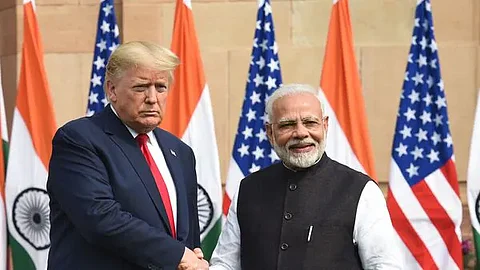

Despite ongoing negotiations, the long-anticipated trade deal between India and the US remains elusive. With the US having recently signed pacts with other major economies including Japan and the European Union, the absence of a breakthrough with India has raised eyebrows in policy and investor circles.
In contrast, the US–China agreement on tariffs and export controls, signed in May with an August 12 deadline, is likely to be extended, according to analysts. Officials from both countries resumed talks on Monday in Stockholm, Sweden.
There has been no comparable progress in the India–US trade negotiations—at least none that has been made public. On July 24, India’s Ministry of External Affairs stated that both countries were working toward finalising the “first tranche of a mutually beneficial, multi-sector Bilateral Trade Agreement (BTA).”
Hopes were high that an agreement would be reached before the earlier deadline of July 9, set by Donald Trump. Despite multiple rounds of discussions and reports indicating that a final decision was imminent, no deal was announced.
One of the key sticking points is Washington’s demand for greater access to India’s agriculture sector, particularly in dairy and genetically modified (GM) products. India has resisted these demands, citing risks to domestic livelihoods.
“The US wants more access to India’s agriculture market, particularly dairy products. India cannot and is unwilling to negotiate on this. Animal farming here is a source of livelihood for millions, not a large-scale industry like in the Western world,” said VK Vijayakumar of Geojit Financial Services.
India is also reportedly seeking lower tariff rates to remain competitive with its Asian peers. Another complicating factor is the US stance on countries continuing to import oil from Russia. Last week, US Senator Lindsey Graham warned that the Trump administration may impose steep tariffs on nations that fail to comply—India among them.
Despite the roadblocks, many experts remain cautiously optimistic. While the 26 percent tariffs on Indian exports are set to take effect from August 1, both sides could opt to sign an interim or "basic" agreement, deferring negotiations on a comprehensive pact to October or November.
“A deal is important not only for India but also for the US due to geopolitical compulsions,” said G Chokkalingam, founder and head of research at Equinomics Research.
Media reports indicate that a team of US negotiators is expected to visit New Delhi in the second half of August for the next round of discussions.
Further delay in finalising the trade deal could weigh on Indian markets, which are already under pressure. A continued stalemate may worsen concerns around the trade deficit and the rupee’s depreciation. Conversely, even a partial agreement could act as a short-term catalyst for equities.
“If India signs a deal with the US and avoids the 26 percent reciprocal duties, the market is likely to recover significantly. But if duties are imposed, equities could remain under pressure in the short term,” said Chokkalingam.
Foreign portfolio investors (FPIs), who have been net sellers of Indian equities this month, could also shift stance in the event of a favourable agreement.
“Over the medium term, such a deal would likely boost FPI inflows into sectors like manufacturing, technology and healthcare—especially as part of the global China+1 diversification strategy,” said Aditya Sood, fund manager at InCred Asset Management. “It would also reinforce long-term stability and economic integration, which are key for long-duration global investors.”
However, in the long run, markets will focus more on structural indicators—particularly GDP growth and a sustained recovery in earnings—to support current valuations.
(By arrangement with livemint.com)